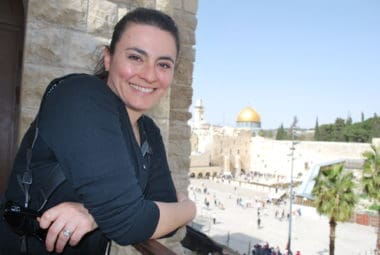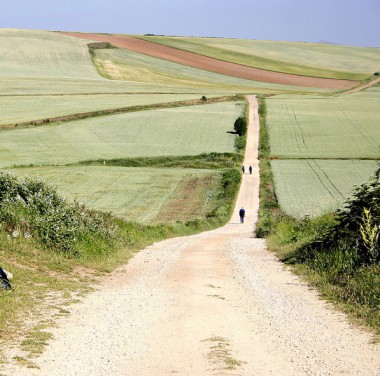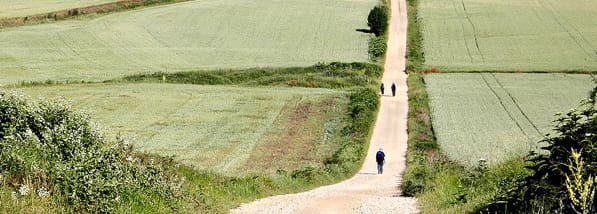For me, pilgrimage has always meant coming home to a place where I am loved. You know that feeling of security you get with family, knowing that even though they know all your crazy quirks, they love you anyway? That’s pilgrimage. Finding refuge in a chapel, away from life’s insecurities. Seeking understanding and familiarity in a foreign country, where I don’t speak the language. Resting in a haven of peace and tranquility in the midst of a busy city. I go on pilgrimage because, in the midst of my life’s pilgrimage, I need reassurance, I need reminders that no matter what, God is with me and He loves me more than I love myself. No matter where I am, in a Catholic church, I am home and I am welcome. That sustains me.
There are many reasons why I go on pilgrimage–to learn, to give thanks, to petition, to remember, to honor. Early Christians made valiant treks to the Holy Land to visit the places of Christ’s life, death, and resurrection.  Having made the trip myself recently, I recommend it wholeheartedly! Chaucer’s Canterbury Tales recounts the journeys of 14th-century pilgrims traveling to England’s Canterbury Cathedral, where St. Thomas Becket was cruelly martyred. (I saw that, too!) Spain’s Camino de Santiago de Compostela, which dates to the 9th century, was one of three pilgrimages that provided pilgrims with a plenary indulgence. The other two were the Via Francigena from Canterbury to Rome, and the pilgrimage to Jerusalem.
Having made the trip myself recently, I recommend it wholeheartedly! Chaucer’s Canterbury Tales recounts the journeys of 14th-century pilgrims traveling to England’s Canterbury Cathedral, where St. Thomas Becket was cruelly martyred. (I saw that, too!) Spain’s Camino de Santiago de Compostela, which dates to the 9th century, was one of three pilgrimages that provided pilgrims with a plenary indulgence. The other two were the Via Francigena from Canterbury to Rome, and the pilgrimage to Jerusalem.
 Today, pilgrims flock to these locations and many others, including the sites of apparitions of Jesus and Mary, such as Lourdes, France, Knock, Ireland, Akita, Japan, or Kibeho, Rwanda. Penitent pilgrims trek barefoot up Ireland’s Skellig Michael or on their knees to Fatima, Portugal. Curious pilgrims visit the miraculous image of Our Lady of Guadalupe on St. Juan Diego’s tilma in Mexico City, the incorrupt bodies of Saints John Vianney, Bernadette Soubirous and Catherine Labouré, or the Eucharistic miracles in Siena and Lanciano, Italy, or Seefeld, Austria. Many, like me, love to soak up the ambient holiness in cities where saints once lived, like St. Teresa’s Avila, Padre Pio’s Pietrelcina and San Giovanni Rotondo, and St. Francis’ and St. Clare’s Assisi.
Today, pilgrims flock to these locations and many others, including the sites of apparitions of Jesus and Mary, such as Lourdes, France, Knock, Ireland, Akita, Japan, or Kibeho, Rwanda. Penitent pilgrims trek barefoot up Ireland’s Skellig Michael or on their knees to Fatima, Portugal. Curious pilgrims visit the miraculous image of Our Lady of Guadalupe on St. Juan Diego’s tilma in Mexico City, the incorrupt bodies of Saints John Vianney, Bernadette Soubirous and Catherine Labouré, or the Eucharistic miracles in Siena and Lanciano, Italy, or Seefeld, Austria. Many, like me, love to soak up the ambient holiness in cities where saints once lived, like St. Teresa’s Avila, Padre Pio’s Pietrelcina and San Giovanni Rotondo, and St. Francis’ and St. Clare’s Assisi.
A pilgrimage doesn’t necessarily require expensive and time-consuming trips overseas. In the first season of The Faithful Traveler, my husband and I visited some amazing places of pilgrimage, all within a few hours’ drive of our home. We visited Emmitsburg’s National Shrine of St. Elizabeth Ann Seton, where the first American saint once lived; Newark’s Cathedral Basilica of the Sacred Heart, which has windows that rival those of Chartres Cathedral in France; and the Basilica of St. Patrick’s Old Cathedral, where Catholics stood their ground in the face of discrimination in the early days of our country. Closer to home, we are blessed with five amazing shrines–the National Shrine of St. Rita of Cascia, the Miraculous Medal Shrine, the National Shrine of St. Katherine Drexel [April 2017 editor’s update: because of the dwindling number of sisters, the shrine is set to close at the end of 2017 and Katherine’s remains moved to Philadelphia], the National Shrine of Our Lady of Czestochowa, and the National Shrine of St. John Neumann–two of which house the remains of saints!
Pilgrimages begin long before we leave home, as we prepare physically and spiritually. That’s one of the reasons  why we created The Faithful Traveler, to show pilgrims what they would see at the shrines we visit and why it should mean something to them. We might start a walking regimen before going to the Holy Land or the Camino de Santiago, read a book written by the saint whose city we’re going to visit, or pray a 54-Day Rosary Novena, asking for a fruitful pilgrimage that helps us grow in holiness. Many pilgrims make a sacrifice of their journey, by walking great lengths to their destination or by living an ascetic lifestyle during the trip, offering up luxurious hotel rooms and sumptuous meals in exchange for sparse lodging and light fare.
why we created The Faithful Traveler, to show pilgrims what they would see at the shrines we visit and why it should mean something to them. We might start a walking regimen before going to the Holy Land or the Camino de Santiago, read a book written by the saint whose city we’re going to visit, or pray a 54-Day Rosary Novena, asking for a fruitful pilgrimage that helps us grow in holiness. Many pilgrims make a sacrifice of their journey, by walking great lengths to their destination or by living an ascetic lifestyle during the trip, offering up luxurious hotel rooms and sumptuous meals in exchange for sparse lodging and light fare.
Once we arrive, the possibilities for spiritual and intellectual growth are endless. One of my favorite things to do on pilgrimage is admire and photograph the art, whether it be stained glass windows, statues, paintings, mosaics, or Stations of the Cross. I like to see beautiful things devoted to God because they remind me that He gave us the materials we use to honor Him, He gave us the ability to use those tools to make beautiful things, and He gave us hearts full of love that make us want to honor Him.
Once the art sends my mind and heart to reeling up to God, I get down to business and visit with my Heavenly relatives. I thank God for all of His gifts and I offer Him whatever weighs on my heart. I pray to the Blessed Mother, to St. Joseph, her wonderful spouse, and to any saints whose statues I come across. Shrines are also a great place to learn about the lives of saints and to let their example show you new ways to deal with life’s dilemmas. They motivate me, inspire me, and help shoulder my cross a little better. And at the end of the day, all of this does the one thing that matters the most: it brings me closer to God here on earth so that I might, someday, be closer to Him in Heaven. It’s like Continuing Ed for those of us who want our St. degree.
While I can’t presume to know what God thinks of all of this, I’ll bet He likes it. Just like any other relationship in our lives, God wants us to talk to Him (prayer), to be intimate with Him (communion), to be friends with Him, and to love Him. A pilgrimage is a wonderful way to continue, or even begin, our relationship with God.
I am thrilled to be able to share my experiences of pilgrimage with you–be they places I’ve been or places I dream of visiting–through this website. And I hope that my faithful travels will inspire your own.
+
Art: Diana von Glahn in the Holy Land photograph used with permission. Nuestra Señora de Guadalupe holy card image; Some European pilgrims on the road to Santiago de Compostela, Oula Lehtinen, own photograph, 11.06.2005, CCA-SA; Wikimedia Commons.





